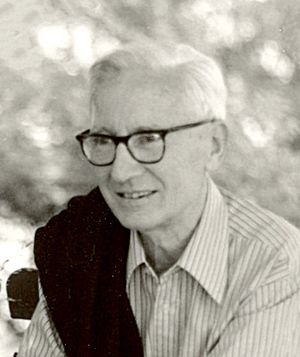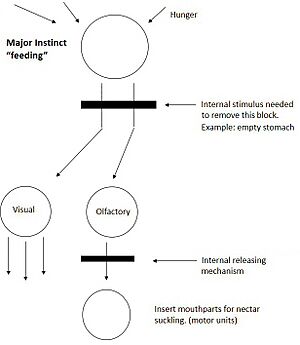Nikolaas Tinbergen facts for kids
Quick facts for kids
Niko Tinbergen
|
|
|---|---|

Tinbergen in 1978
|
|
| Born |
Nikolaas Tinbergen
15 April 1907 The Hague, Netherlands
|
| Died | 21 December 1988 (aged 81) Oxford, England
|
| Alma mater | Leiden University |
| Known for |
|
| Spouse(s) | Elisabeth Rutten (1912–1988) |
| Children | 5 |
| Awards |
|
| Scientific career | |
| Fields | |
| Institutions | University of Oxford |
| Doctoral advisor | Hilbrand Boschma |
| Doctoral students |
|
| Influenced |
|
Nikolaas "Niko" Tinbergen (1907–1988) was a Dutch scientist who studied animals. He was a biologist and also an ornithologist, meaning he studied birds. In 1973, he won the Nobel Prize in Physiology or Medicine. He shared this award with two other scientists, Karl von Frisch and Konrad Lorenz. They won for their amazing discoveries about how animals behave. Tinbergen is known as one of the main founders of modern ethology. This is the scientific study of animal behavior.
In 1951, Tinbergen wrote an important book called The Study of Instinct. This book greatly influenced how people understood animal behavior. He also worked on wildlife films in the 1960s. These films included The Riddle of the Rook and Signals for Survival. The film Signals for Survival even won a special award called the Italia prize.
Contents
Early Life and Learning
Niko Tinbergen was born in The Hague, Netherlands. He was one of five children in his family. His brother, Jan Tinbergen, also won a Nobel Prize in Economics in 1969. They are the only brothers to both win a Nobel Prize! Another brother, Luuk Tinbergen, was also a well-known biologist.
Niko loved nature from a young age. He studied biology at Leiden University. During World War II, he was held captive. After the war, Tinbergen moved to England. There, he taught at the University of Oxford. Many of his students became famous biologists. These include Richard Dawkins and Desmond Morris.
Understanding Animal Instincts
In 1951, Tinbergen's book The Study of Instinct was published. This book is still very important for scientists who study animal behavior. It explains Tinbergen's ideas about behaviors that animals are born with. These are called innate behaviors. He also looked at how these behaviors help animals survive and how they developed over time.
Tinbergen defined behavior as all the movements an animal makes. Innate behavior is behavior that an animal does not learn. It happens naturally. A main question in his book was how things inside and outside an animal control its behavior.
He was especially interested in "spontaneous" behaviors. These are actions an animal performs perfectly the first time. They also seem to be unaffected by learning. Tinbergen explained that behavior is a mix of these natural patterns. It is also a series of reactions to specific signals. Behavior reacts to outside signals. But it also depends on internal factors.
His ideas about how behaviors are triggered built on the work of Konrad Lorenz. Lorenz thought that each instinctive action had a special energy. This energy would build up in the brain. Tinbergen made this idea more complex. His model is now known as Tinbergen's hierarchical model.
He suggested that urges for behavior build up in parts of the brain. These urges are usually held back by "blocks." These blocks are removed by a special trigger. This allows the energy to flow to the next part of the brain. This continues like a chain reaction until the behavior happens. Tinbergen's model showed that related behaviors are grouped together.
For example, he studied how honey bees find food. He showed that bees were curious about yellow and blue paper flowers. He thought these colors caused energy to build up in one part of their brain. But the bees rarely landed on the paper flowers. They only landed if the right smell was also present. The smell was a chemical signal. It allowed the next step in the chain to happen. This encouraged the bee to land. The final step was for the bee to put its mouthparts into the flower and start sucking. Tinbergen saw this as the end of the honey bee's feeding behavior.
Winning the Nobel Prize
In 1973, Tinbergen, Konrad Lorenz, and Karl von Frisch won the Nobel Prize in Physiology or Medicine. They won for their discoveries about how animals organize and show individual and social behaviors. The award recognized their studies on behaviors that are programmed in an animal's genes. They also studied how these behaviors develop and what triggers them.
In his Nobel speech, Tinbergen talked about how unusual it was for the Nobel Foundation to give this prize to "animal watchers." But he said that their way of "watching and wondering" about animal behavior could help people.
The work of these three scientists on fish, insects, and birds created a base for more studies. It helped understand how important certain experiences are when animals develop. It also showed the effects of unusual social situations in mammals. At the time, these discoveries were seen as a big step forward. They helped understand problems like anxiety and repetitive behaviors in people. Tinbergen's part in these studies included testing ideas with careful experiments. His work also looked at "supernormal stimuli." His research was also thought to have possible uses for studying how children develop and behave.
Other Awards and Honors
Niko Tinbergen received many honors during his life. In 1950, he became a member of the Royal Netherlands Academy of Arts and Sciences. He was also chosen as a Fellow of the Royal Society (FRS) in 1962. He joined the American Academy of Arts and Sciences in 1961. Later, he became a member of the United States National Academy of Sciences in 1974. He also received several medals for his work.
Tinbergen's Four Questions
Tinbergen believed there were four main questions to ask about any animal behavior. These questions help us understand why animals do what they do:
- What causes the behavior? What signals make the animal act this way? How has learning changed it? How do the body and mind work together to create this behavior?
- How does the behavior develop? How does the behavior change as the animal gets older? What early experiences are needed for the behavior to appear? What steps in development and what environmental factors are important?
- What is the behavior's purpose? How does this behavior help the animal survive and reproduce?
- How did the behavior evolve? How does this behavior compare to similar behaviors in related animals? How might it have developed over many generations?
In the study of animal behavior, the first two questions (what causes it and how it develops) are called "proximate mechanisms." The last two questions (its purpose and how it evolved) are called "ultimate mechanisms." These four questions are still very important for studying animal behavior today.
Supernormal Stimuli
A big part of Tinbergen's research was about what he called the supernormal stimulus. This is an artificial object that is a stronger trigger for an animal's instinct than the real object.
For example, he made plaster eggs to see which ones birds preferred to sit on. He found that birds would choose eggs that were larger, had clearer markings, or brighter colors. A super-bright egg with black polka dots would be chosen over the bird's own natural eggs.
Tinbergen also found that male three-spined stickleback fish would attack a wooden fish model more strongly than a real male fish if its underside was redder. He also made cardboard butterflies with more defined markings. Male butterflies would try to mate with these fake butterflies instead of real females. The supernormal stimulus, by being exaggerated, clearly showed what features were triggering the animal's natural response.
Personal Life
Tinbergen was married to Elisabeth Rutten. They had five children together. He passed away on December 21, 1988, in Oxford, England, after having a stroke.
Images for kids
See also
 In Spanish: Nikolaas Tinbergen para niños
In Spanish: Nikolaas Tinbergen para niños



